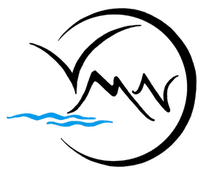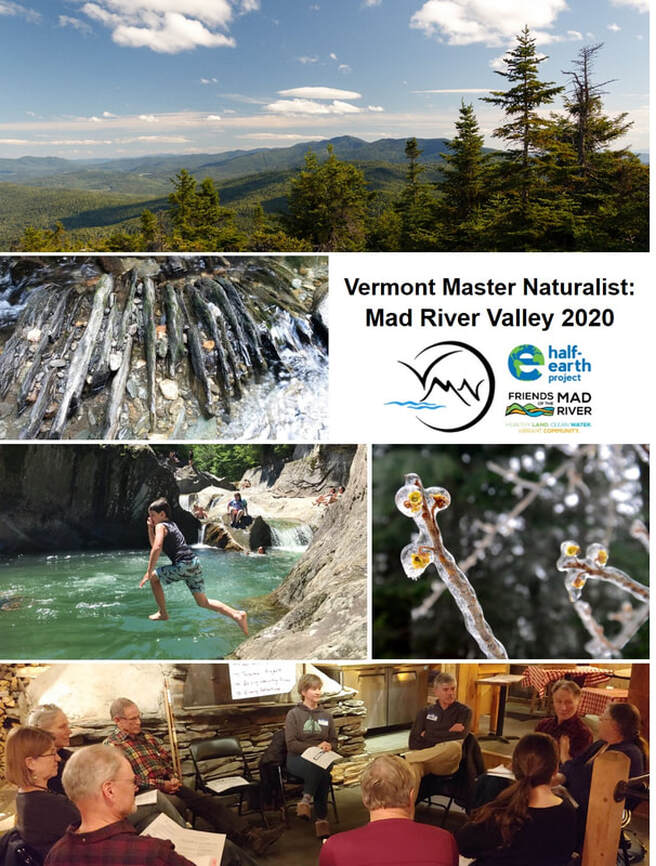Exploring what is underfoot, overhead, & making the Mad River Valley home!
2020 is 1st Mad River Valley Cohort
|
About Vermont Master Naturalist

Vermont Master Naturalist emphasizes deep investigation at the local level, and training naturalists to serve as environmental ambassadors. VMN began in Burlington in 2016, where it is has trained cohorts of master naturalists since. Over 200 people have graduated from the Vermont Master Naturalist Program new regional programs in the Middlebury area ,Winooski Headwaters, and Mad River Valley. Alicia Daniel, VMN Founder, is a lead faculty with University of Vermont’s Field Naturalist Program, and has adapted this graduate-level approach for Vermont communities. "To develop intimacy with people it is necessary to understand their history; the same holds true for developing an intimate relationship with place." -Tom Wessels |
Stewardship -
Following the core training, teams of candidates are matched with partnering conservation organizations to undertake stewardship and engagement projects of at least 20 hours per person. These teams are arranged and paired with partner organizations by VMN, Friends of the Mad River, and Vermont Alliance for Half-Earth. Upon completion, certified Vermont Master Naturalists will continue to support the local community, while receiving continued mentorship in their future naturalist endeavors.
When - Field day trainings are scheduled on four Sundays and one Saturday, from 10 am to 4 pm.
Following the core training, teams of candidates are matched with partnering conservation organizations to undertake stewardship and engagement projects of at least 20 hours per person. These teams are arranged and paired with partner organizations by VMN, Friends of the Mad River, and Vermont Alliance for Half-Earth. Upon completion, certified Vermont Master Naturalists will continue to support the local community, while receiving continued mentorship in their future naturalist endeavors.
When - Field day trainings are scheduled on four Sundays and one Saturday, from 10 am to 4 pm.
- March 15 - Geology, Winter Ecology & Wildlife Tracking (CANCELLED and to be rescheduled due to Covid-19 pandemic) :(
- May 16 (Saturday) - Glacial History, Soils, & Wildflowers
- June 14 - A Dynamic Mad River & Watershed
- September 13 - Land Use History & Forest Forensics
- October 18 - A Celebration of Fall, MRV Conservation Successes, & Graduates
Want to Join the Next Cohort?
While we've selected 2020 participants, we'd like to know if there is interest in a second year of VMN in the Mad River Valley. If you're interested in being on our contact list, let us know here.
Course Resources
- Reading the Forested Landscape by Tom Wessels. This book help you to read the history of land use and landscape change.
- Wetland, Woodland, Wildland: A Guide to the Natural Communities of Vermont by Liz Thompson, Eric Sorenson & Bob Zaino. This book describes the natural communities of Vermont and the common associations of plants that we will see around the Valley. It’s a great reference guide. Consider the newest edition, published in 2019.
- Nature’s Best Hope: A New Approach to Conservation That Starts in Your Yard by Doug Tallamy. This book explains the importance of providing native plant habitat for caterpillars, pollinators, birds and more to sustain biodiversity in an age of climate change.
- Half Earth: Our Planet's Fight for Life by E.O. Wilson. A visionary way to approach conservation from the whole world to our own backyards.
- More on Vermont Master Naturalist's Resource Page.
2020 Mad River Valley Program Handbook
Contact
Feel free to contact us with questions or comments or interest.
Curt Lindberg, VMNMRV Coordinator
Email - [email protected]
Curt Lindberg, VMNMRV Coordinator
Email - [email protected]
Want to Sustain this Offering in the Mad River Valley?
We haven't yet raised the full support it takes to bring this program to the Mad River Valley. If you'd like to support it in 2020 or beyond, please click on the Donate button below and be sure to note "Vermont Master Naturalist" in the note column. Many thanks!
Photos by: Corrie Miller, C.H. Diegel, Amy Todisco, Brad Long, Corrie Miller (top to bottom, left to right)

